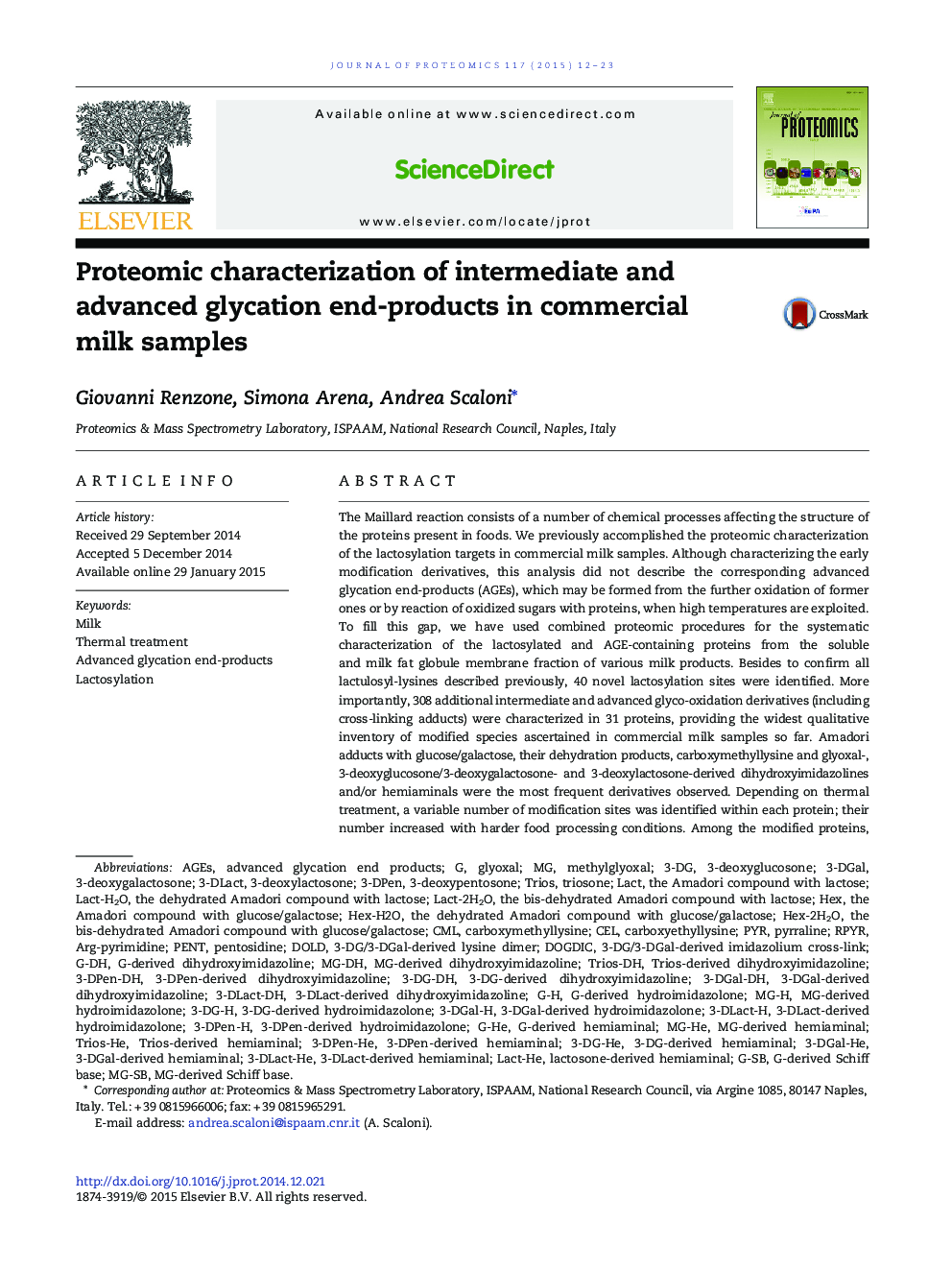| کد مقاله | کد نشریه | سال انتشار | مقاله انگلیسی | نسخه تمام متن |
|---|---|---|---|---|
| 1225700 | 1494763 | 2015 | 12 صفحه PDF | دانلود رایگان |
• Shotgun proteomics was used for the characterization of glyco-oxidized proteins in commercial milks.
• Hundreds of intermediate and advanced glyco-oxidation adducts were assigned in 31 milk proteins.
• Dozens of different linear and cross-linked derivatives were ascertained.
• Proteins involved in nutrient delivery, defense response and cellular proliferation/differentiation were highly modified.
The Maillard reaction consists of a number of chemical processes affecting the structure of the proteins present in foods. We previously accomplished the proteomic characterization of the lactosylation targets in commercial milk samples. Although characterizing the early modification derivatives, this analysis did not describe the corresponding advanced glycation end-products (AGEs), which may be formed from the further oxidation of former ones or by reaction of oxidized sugars with proteins, when high temperatures are exploited. To fill this gap, we have used combined proteomic procedures for the systematic characterization of the lactosylated and AGE-containing proteins from the soluble and milk fat globule membrane fraction of various milk products. Besides to confirm all lactulosyl-lysines described previously, 40 novel lactosylation sites were identified. More importantly, 308 additional intermediate and advanced glyco-oxidation derivatives (including cross-linking adducts) were characterized in 31 proteins, providing the widest qualitative inventory of modified species ascertained in commercial milk samples so far. Amadori adducts with glucose/galactose, their dehydration products, carboxymethyllysine and glyoxal-, 3-deoxyglucosone/3-deoxygalactosone- and 3-deoxylactosone-derived dihydroxyimidazolines and/or hemiaminals were the most frequent derivatives observed. Depending on thermal treatment, a variable number of modification sites was identified within each protein; their number increased with harder food processing conditions. Among the modified proteins, species involved in assisting the delivery of nutrients, defense response against pathogens and cellular proliferation/differentiation were highly affected by AGE formation. This may lead to a progressive decrease of the milk nutritional value, as it reduces the protein functional properties, abates the bioavailability of the essential amino acids and eventually affects food digestibility. These aspects are of particular importance in products intended for infant diet, such as milk powders and infant formulas.Biological significanceWe used combined shotgun proteomic procedures for the systematic characterization of intermediate and advanced glycoxidation protein products in various raw and commercial milk samples. Several hundreds of modified species were characterized as deriving from 31 milk proteins, providing the widest qualitative inventory of assigned components in this fluid. Amadori adducts with glucose/galactose, their dehydration products, carboxymethyl-lysine, and glyoxal-, 3-deoxyglucosone/3-deoxygalactosone- and 3-deoxylactosone-derived dihydroxyimidazolines and/or hemiaminals were the most frequent derivatives observed. Proteins involved in nutrient delivery, defense response against pathogens and cellular proliferation/differentiation were highly subjected to intermediate and advanced glyco-oxidation modification. This may lead to a progressive decrease of the milk nutritional value, as it reduces the protein functional properties, diminishes the bioavailability of the essential amino acids, eventually affects food digestibility and determines a potential increase of specific allergens. These information are important points of interest to connect the extent of the Maillard reaction present in different commercial samples with the potential nutritional aspects mentioned above. These themes have to be fully evaluated in a next future for a complete estimation of the nutritional and toxicological properties of the dairy products deriving from severe heat processing.
Figure optionsDownload high-quality image (113 K)Download as PowerPoint slide
Journal: Journal of Proteomics - Volume 117, 18 March 2015, Pages 12–23
